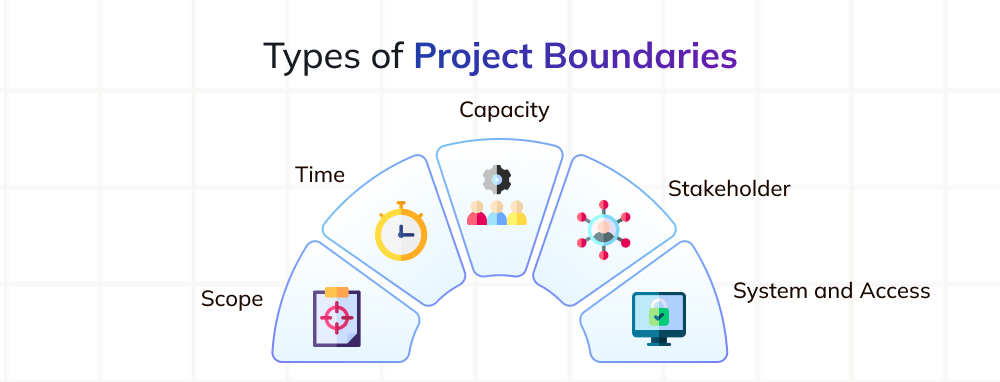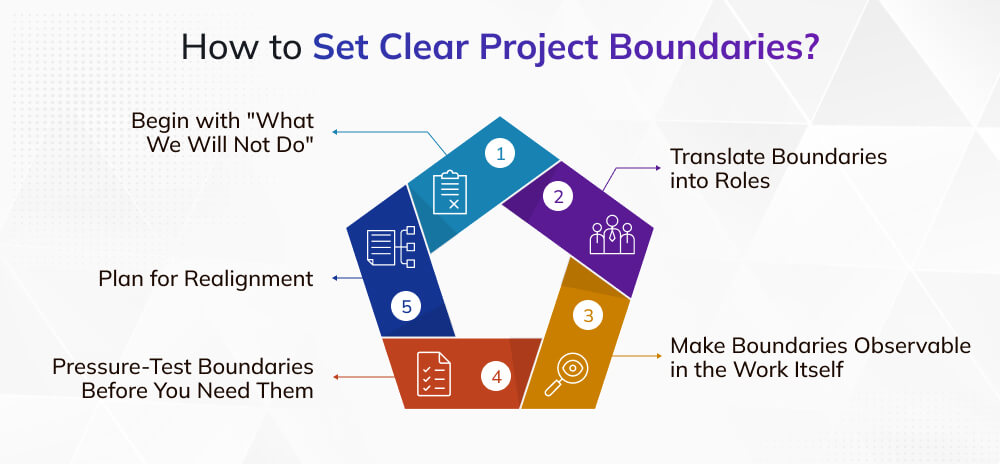
Project boundaries are one of the most overlooked yet defining factors in project success. When they’re clearly defined, teams stay aligned, deliverables stay focused, and risks are easier to manage. When they’re not, even high-performing teams end up feeling overwhelmed, misaligned, or worse, completely off course.
Think about it: How often do deadlines get pushed, scope expands without warning, or roles become blurred, despite a strong kickoff? In most cases, it’s not poor execution; it’s unclear boundaries at play.
| According to the Harvard Business Review, 1 in 6 projects runs 70% over schedule and exceeds budget by nearly 200%, largely due to unclear scope and shifting expectations. |
One seasoned project manager recalled how a lack of clear boundaries slowly turned a manageable role into a relentless cycle of 12-hour workdays. As the demands continued to grow and expectations remained undefined, the pressure spilled over onto the rest of the team.
Despite raising the issue with leadership and pushing back on capacity limits, the outcome wasn’t support; it was dismissal. It’s a sobering reminder of how boundary neglect doesn’t just strain timelines, it strains people.
That’s why understanding and establishing project boundaries is a critical leadership skill, not just a planning task. Boundaries define what the project is and what it isn’t, who’s responsible for what, and what resources are available. In other words, they create the protective structure that prevents chaos from creeping in.
In this blog, you’ll learn:
- What project boundaries are
- Key types of boundaries to define early
- Real examples of clear vs. ambiguous boundary situations
- And a step-by-step guide to setting them up without friction
What Are Project Boundaries?
A project boundary defines the limits of what the project is responsible for, and just as importantly, what it is not. Boundaries clarify expectations, prevent overreach, and enable project managers to make informed decisions about scope, time, and resource allocation.
| “Boundaries are not restrictions, they’re agreements. Without them, you’re not executing a project; you’re reacting to one.” |
Think of them as operational guardrails. Without them, even experienced teams can find themselves pulled into requests, tasks, or risks that were never part of the original mandate.
These boundaries are usually captured in the project scope statement, the charter, and kickoff documentation, helping teams align on:
- The starting and ending points of the project’s work
- What lies outside the team’s responsibility
- The constraints related to time, resources, and stakeholder decisions
Why Boundaries Make or Break Project Execution
When project boundaries are unclear, execution doesn’t just suffer, it destabilizes the project. Tasks often exceed original plans, decisions take longer, and teams begin to operate on assumptions rather than a shared understanding.
Unclear boundaries often lead to:
- Misinterpreted priorities across departments
- Rework caused by conflicting stakeholder expectations
- Delayed decisions due to unresolved ownership
When no one knows where their responsibility ends or how far the scope stretches, even routine meetings turn into negotiations. That ambiguity creates decision fatigue—a silent but costly threat to project momentum.
Project boundaries also serve as an internal alignment tool. They ensure the development team isn’t chasing marketing-led additions mid-sprint, or finance isn’t reallocating resources without upstream visibility. Without them, cross-functional projects often stall, not due to a lack of effort, but because of the absence of defined limits.
The most successful delivery environments treat boundary-setting as a leadership responsibility, not just a documentation task. It’s how they protect the clarity and integrity of execution from the very beginning.
Types of Project Boundaries You Must Define
Project boundaries aren’t just about scope; they represent multiple dimensions of control. Whether it’s who’s involved, what’s being delivered, or how far your resources can stretch, every boundary shapes the reality of your project.
Below are five foundational boundaries every project manager should define, each critical in preventing derailments.
1. The “In vs. Out” Line: Scope Boundaries
This boundary defines what the project will deliver and what it intentionally won’t. It ensures that the team doesn’t drift into work that sounds relevant but sits outside the approved objectives.
For example, if you’re improving internal operations in one country, enhancements to global offices, even if related, would fall outside the scope of the project.
Scope boundaries should be captured through tools like the Work Breakdown Structure (WBS) and validated through stakeholder review to avoid costly surprises later.
2. The Clock Constraint: Time Boundaries
Time boundaries define the duration within which the team must execute the work, including milestones, deadlines, and cut-off points for revisions. Without time boundaries, change requests can linger indefinitely, and retrospectives turn into recurring project phases.
A construction firm, for instance, might define in its project charter that post-completion maintenance checks will occur once to six months after handover. Any further requests are outside the boundary and require a new agreement.
Utilize Gantt charts, critical path analysis, and milestone reviews to enforce these limits and ensure delivery accountability.
3. The Resource Perimeter: Capability Boundaries
These boundaries define the resources—human, financial, and technical —that are committed to the project. They protect teams from being stretched too thin or assuming access to assets that don’t exist.
Say a marketing agency recommends a new brand identity. If their in-house designers are fully allocated, creating a new logo may sit outside their resource boundary, even if the idea is aligned.
Clear resource boundaries also help prevent stakeholder overreach by signaling what’s truly feasible with the team and budget available.
4. The Collaboration Line: Stakeholder Boundaries
Not all stakeholders play the same role. Defining who has influence, decision rights, and deliverable ownership helps prevent role confusion and unnecessary bottlenecks.
At the beginning of a project, map stakeholder roles. For instance, your operations head may provide inputs but not approve the final deployment plan. Communicate this distinction explicitly.
Setting stakeholder boundaries also improves communication cadence by clarifying who receives what updates, how often, and in what format, preventing message fatigue and misalignment.
5. The Technical Fence: System and Access Boundaries
Sometimes overlooked, these boundaries determine which tools, systems, and infrastructure are authorized for use in a project. For example, if a cloud migration project is limited to non-critical workloads, attempting to shift sensitive data systems violates both compliance and boundary agreements. This also includes access levels, which determine who can view, edit, or approve specific data. Failing to define this can lead to compliance breaches or redundant work.
The most resilient projects are those that are as clear about their limits as they are about their goals. These boundary types, when defined at the outset and revisited mid-project, help managers not only execute efficiently but also protect teams, align stakeholders, and deliver with integrity.
How to Set Clear Project Boundaries?
Project boundaries don’t emerge from a single kickoff meeting or a single scope document; they’re the result of deliberate conversations, structured thinking, and ongoing sense-checking as the project evolves.
Below are five powerful practices used by experienced project managers to not only define boundaries, but also embed them into how the project breathes, reacts, and remains resilient.
1. Begin with “What We Will Not Do” – Before You Talk Goals
It’s essential to begin by outlining deliverables and milestones. But experienced project leads often reverse that flow by first identifying what the project won’t include. This negative space brings more clarity than you’d expect.
Why? Because ambiguity lives in the grey zones. Defining what falls outside the project, certain departments, technologies, or timeframes, eliminates false expectations before they form.
In a cross-border logistics project, for example, a team explicitly excluded customs optimization outside Southeast Asia. It saved weeks of stakeholder debate downstream. That exclusion statement became a daily reference point, especially when adjacent regional teams requested add-ons that could’ve derailed delivery.
| This “anti-scope” exercise is a boundary-shaping ritual in many high-performance teams. When done early, it’s easier to communicate and enforce. When skipped, teams find themselves negotiating while executing their tasks. |
2. Translate Boundaries into Roles, Not Just Statements
Setting boundaries on paper isn’t enough. They must become lived experiences for your team, and that only happens when they’re mapped to roles and responsibilities.
Begin with your stakeholder ecosystem. Who makes scope decisions? Who approves the budget? Who communicates with external vendors? This goes beyond RACI charts. What you want is boundary clarity per role, knowing not just what someone does, but where their authority starts and ends.
One global consulting firm embeds “Boundary Accountability Cards” into its kickoff rituals. Each role card has a section that reads: “This role is not responsible for…” It’s subtle but powerful. When disputes arise, the team isn’t relying on memory or emails. The boundary was structurally built into the role itself.
This clarity also reduces overlap, duplicate effort, and confusion about ownership, a top contributor to project friction in matrixed organizations.
3. Make Boundaries Observable in the Work Itself
It’s not enough for project boundaries to exist in planning documents; they need to be visible in how the Work unfolds. That means embedding boundary checks and signals into regular workflows.
In an agile environment, this could look like:
- Reviewing scope boundaries in sprint planning
- Adding boundary review checkpoints in retrospectives
- Including “boundary impact” fields in Jira or task tracking tools
In traditional waterfall models, this might mean:
- Time-blocked phase gates that don’t allow crossover deliverables
- Budget reviews tied to original cost tolerances
- Approval matrices embedded into document workflows
4. Pressure-Test Boundaries Before You Need Them
Here’s where most PMs get caught off guard: boundaries often feel solid until pressure hits. Stakeholders change priorities. Clients ask for last-minute features. Teams burn out due to hidden resource creep.
The smart move? Treat early-phase changes as simulated breach tests. Any time a request comes in that even slightly impacts scope, time, or budget, log it. Review:
- Was the boundary understood?
- Was the decision clear?
- Was the response consistent?
Use these early changes to strengthen communication protocols. If it took four emails and two meetings to reject a small request, your boundary enforcement isn’t yet efficient.
Think of boundary pressure as data. It tells you where your team needs better tools, stronger language, or executive reinforcement.
5. Plan for Realignment – Boundaries Are Living, Not Fixed
Projects evolve. And if your boundaries don’t evolve with them, one of two things happens: either people stop respecting them, or your project becomes misaligned with reality.
The solution isn’t constant change; it’s planned recalibration. Set mid-project checkpoints where you revisit the boundaries:
- Has the scope expanded formally or informally?
- Are all stakeholders still aligned on what success looks like?
- Have any external constraints shifted (e.g., budget cuts, regulatory changes)?
Make this a recurring part of your governance model. Re-baseline scope and re-communicate boundaries if needed, but do it intentionally, not defensively.
Setting project boundaries isn’t a single task; it’s a series of informed leadership choices. Whether you’re excluding scope up front, mapping limits to roles, embedding governance into daily work, or negotiating shifts mid-project, what you’re doing is protecting the integrity of execution.
What Happens When Project Boundaries Aren’t clear?
When project boundaries are vague, what follows isn’t just inefficiency, it’s confusion, conflict, and collapse. These pitfalls don’t appear overnight. They creep in quietly, often disguised as good intentions: helping another team, stretching a timeline “just this once,” accommodating a sponsor’s request midstream.
Below, we examine the five most critical consequences of unclear boundaries, each shaped by how real projects break down, not just theory.
1. The Disappearing Scope Trap
When boundaries aren’t clearly drawn, scope becomes fluid, and that’s where trouble begins. What starts as “just one more feature” can quickly unravel into a cascade of unplanned deliverables.
The result?
- Overloaded teams
- Diluted outcomes
- And timelines that expand without control
A classic example: a website redesign project that started with UX updates but ended up absorbing branding, SEO, and content overhaul, all without added time or budget.
| Unclear scope boundaries are the number one contributor to scope creep, which affects 52% of all projects, according to the PMI. |
2. Shadow Ownership and Role Confusion
Without boundaries, accountability becomes negotiable. Multiple people start making decisions about the same deliverable. Others assume someone else “owns it.” Tasks fall between roles, and deadlines are missed not because of a lack of effort, but due to ambiguity in ownership.
Project managers in cross-functional environments face this often. A lack of role-based boundaries leads to:
- Decision paralysis
- Conflicting stakeholder expectations
- Blame-shifting when deliverables stall
Even strong teams underperform when no one knows who’s holding the reins.
3. The Silent Time Leak
No boundary is tested more frequently than the project timeline. When time constraints are not well-protected, meetings proliferate, priorities become blurred, and team velocity declines.
| In fact, 58% of the average knowledge worker’s time is spent coordinating work instead of executing it, according to HRM. This coordination overhead intensifies when project timelines lack well-defined boundaries. |
You won’t see it immediately, but days start slipping between handoffs, reviews are delayed “just until next week,” and the Gantt chart becomes a wish list rather than a plan.
The cost isn’t just time. It’s credibility erosion, with stakeholders starting to question your ability to deliver.
4. Conflict Masquerading as Collaboration
A lack of boundaries often appears as over-collaboration at first. Everyone wants to contribute, weigh in, and help shape the outcome. However, without defined limits on decision authority, collaboration can mutate into misalignment.
Team leads argue over requirements. Departments push for their priorities. PMs are stuck in the middle, trying to balance voices without a framework to do so. This doesn’t just slow projects; it breeds resentment and politicization. Collaboration works when boundaries are in place, not when they’re absent.
5. Change Becomes a Threat, Not a Process
Every project faces change. But without clearly defined boundaries, change is treated as disruption rather than adaptation. Requests come in sideways, mid-execution adjustments are made verbally, and decisions are often justified by “urgency” rather than a clear structure.
What’s missing here? A boundary-informed change control process. One that evaluates:
- Is this request in or out of scope?
- What boundary does it affect – timeline, budget, resources?
- Who decides whether to approve?
When boundaries are unclear, change doesn’t follow a process. It circumvents it. And the project spirals quietly off-course.
Projects don’t derail because teams lack skill. They derail because the project’s edges were never clearly defined, and therefore, never defended.
Clear boundaries are not barriers. They serve as blueprints for accountability, clarity, and integrity in execution. When they’re missing, your project becomes a moving target, one that even the best team can’t hit consistently.
The Impact of Clear Boundaries on Project Success
Clear project boundaries aren’t just a matter of documentation; they’re a strategic asset that shapes how a project performs across every layer of execution. When well-defined, boundaries do more than prevent scope creep; they enable clarity, speed, accountability, and collaboration.
Below are three critical areas where boundaries transform not just project flow, but project outcomes.
1. From Activity to Accountability: Sharpening Ownership and Focus
In projects where boundaries are clear, team members don’t just stay busy; they stay aligned. Each person understands where their responsibility begins and ends, which tasks fall within their scope, and when to escalate instead of improvise.
This isn’t about micromanagement, it’s about empowered autonomy. When scope-aligned boundaries define roles, contributors are free to make decisions confidently, reduce cross-functional friction, and stay productive without second-guessing their authority.
2. From Meetings to Movement: Enabling Efficient Communication Loops
In many failing projects, communication isn’t lacking; it’s misdirected. Without boundaries, teams waste time negotiating priorities, clarifying ownership, and chasing updates across loosely defined workflows.
However, when boundaries are visible and agreed upon, communication flows more smoothly. Stakeholders know who to reach out to (and who not to). Updates become predictable, not reactive. The team gains what agile systems refer to as “velocity” – the ability to move forward without stopping to realign every few days.
Boundaries reduce conversational clutter. They eliminate cross-talk and improve resolution speed.
| As Harvard Business Review notes, “The average knowledge worker spends nearly 60% of their time coordinating work, not executing it.” Boundaries help reclaim that time by giving structure to collaboration. |
3. From Risk Accumulation to Predictable Delivery
Projects don’t fail all at once; they unravel in fragments. Unclear scope here, unauthorized changes there, and delayed feedback from the wrong stakeholder. All of these are boundary breaches.
But in projects where boundaries are clearly defined and actively monitored, risks don’t compound silently. They’re identified early because the team knows what’s supposed to happen and what’s not.
This doesn’t just reduce rework and delay. It increases delivery predictability, a metric more valuable than speed alone in enterprise project environments. Well-set boundaries also create psychological safety. Team members feel protected from shifting demands and are more likely to raise concerns proactively when something feels out of bounds.
Clear boundaries don’t just prevent failure; they amplify performance. They create the conditions for deep focus, effective coordination, and consistent delivery. More importantly, they allow project managers to lead with confidence, not by controlling every task, but by enabling a system that keeps itself aligned.
In projects where boundaries are explicit, respected, and revisited as needed, success becomes less about luck and more about structure.
Real-World Example to Define Boundaries of a Project
Establishing clear project boundaries isn’t theoretical; it’s a proven success factor evident in real-world projects across various industries. Below are verified case studies that demonstrate how boundary definition, when executed correctly, directly impacts timelines, budgets, and stakeholder satisfaction.
Euro Tunnel: Boundary Definition at Megaproject Scale
Defining Boundaries in a Megaproject
The Eurotunnel, a 50-kilometer underwater rail link between the UK and France, is one of the most complex infrastructure projects ever completed. While its engineering achievement is well known, what’s less discussed is how clear project boundaries were crucial to its delivery.
Key Boundary Practices That Made the Project Work
1. Scope Boundaries Were Non-Negotiable
Before construction began, the scope was clearly defined: two rail tunnels, one service tunnel, specific technical standards, and no midstream additions. This helped prevent stakeholder-driven scope creep, a common risk in government-backed projects.
2. Stakeholder Roles Were Structured Early
The UK and French governments signed a bilateral treaty outlining their respective responsibilities. Delivery was assigned to the private Eurotunnel consortium, while regulatory and legal oversight remained with both national authorities.
3. Risk Boundaries Were Baked into Planning
Major risks, such as geological surprises or cross-border legal conflicts, were addressed early on through contracts, regulatory protocols, and contingency reserves. Everyone knew what risks were inside the delivery team’s control, and which weren’t.
4. Communication Channels Were Boundaries Too
To avoid conflicting decisions, clear communication flows were defined. Technical decisions stayed with engineers; political decisions required joint approval; and public updates followed coordinated scripts.
Although the project faced delays and budget overruns, as many megaprojects do, it was ultimately completed and has operated successfully for decades. What prevented total derailment? Boundaries that were documented, agreed upon, and enforced across every layer, from engineering to international law.
Conclusion
Project boundaries often don’t get the attention they deserve, but they quietly shape the outcome of every project. When boundaries are clear, teams work with greater focus, responsibilities are better aligned, and change is easier to manage. When they’re unclear, scope expands without control, timelines slip, and decision-making slows down.
As this blog has outlined, defining boundaries at the start, reinforcing them throughout the lifecycle, and adjusting them when needed can help project managers avoid common execution issues and deliver more consistently.
For professionals seeking to enhance their project management skills, Invensis Learning offers a range of Project Management courses that cover practical tools, frameworks, and communication techniques to manage boundaries effectively, whether you’re working in Agile, Waterfall, or hybrid environments.
















